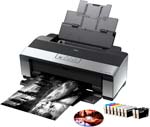Epson Stylus Photo R2880 Review
Review Date: July 28th 2008
Author: Jon Canfield
Leave a comment about this Review
Introduction

Back in 2005 Epson brought out a solid 13x19 inch printer using its new UltraChrome K3 inkset. This model, the Stylus Photo R2400, was a major improvement over the 2200/2100 it replaced, thanks to additional grey inks and a new Advanced Black & White mode in the printer driver. Three years is nearly forever in the digital market though, and we've all been wondering when a replacement would come, and what features it might have. The answer is finally out in the shape of the new Epson Stylus Photo R2880, and it's mostly a good news thing.
Let's get the primary negative out of the way up front. For everyone that was hoping both Photo Black and Matte Black would be installed at the same time, I'm sorry to tell you that you'll still be swapping black cartridges when going from one type of black to the other on the R2880. Why is Epson staying with this system? The main reason is that it would take a total redesign of the print heads in order to support all inks online at once. The larger and more expensive Epson Stylus Pro 3800 goes part way to solving this issue by having all ink cartridges installed, but still only supports one black at a time, and it has to purge ink to swap between Photo and Matte Blacks. With a small printer like the Epson R2880 (did we ever think a 13” printer would be considered small?), there are no real ink lines to purge and minimal ink loss when changing between blacks. So, other than a convenience issue, there is no need in this model for dual blacks onboard.
The Epson R2880 does feature a couple of very welcome enhancements that bring the printer up to the same output quality as the larger 4880, 7880, and 9880 models. The most obvious of these is the replacement of the standard magenta inks with the newest Vivid Magenta and Vivid Light Magenta. These new formulations increase the color accuracy and gamut of the printer, especially in blues and purples. The black and white mode of printing is also improved with better neutrality and virtually no metamerism, and the printer now includes support for printing directly to CD/DVD media.
Compare Prices
Support PhotographyBLOG: Buy the Epson Stylus Photo R2880 from one of our affiliate retailers:
Figure 1
Setup
Setup is quick and straight-forward. The first think you'll notice if you're coming from an older model Epson like the R2400, is the redesign of the case. The printer now matches the look of the 3800, R1900, and R1400 with a clean desigb, and all controls on the top of the printer – nice for those of us that don't like bending over to view status buttons.
In addition to the standard feed, the Stylus Photo R2880 comes with a single sheet adapter for feeding thick media, and roll holders for printing from roll paper up to 13” wide. The Epson R2880 is the only printer offering in this class that supports roll printing, making it a top selection for anyone interested in long panorama prints. Also included, and new to the R2880, is a CD/DVD tray for printing directly to inkjet compatible discs.

Figure 2
After unpacking and removing all the tape and packaging materials, plug the printer in and follow the instructions to insert ink cartridges. While the R2880 charges the print head, you can install the software, including the printer drivers, Epson Print CD, and Epson Printer Utility. During the installation you'll be prompted to connect the printer. The R2880 has dropped the Firewire port found on the R2400, and added a second USB 2.0 port. You can connect the printer to two computers for a limited form of sharing, or you can connect to a wireless print server for network use. It would be nice to have a built-in Ethernet port like the HP B9180, and Epson's larger printers, but as the majority of users will have this connected to a single computer, this is a fair trade-off.
Ink cartridges are small, with about 11ml of ink each. If you do a lot of printing, it's more economical to go with a larger printer and their higher capacity ink tanks, but for most users, the smaller cartridge sizes won't be an issue. Although I don't have quantitative data, ink usage on the R2880 appears to be improved over the previous model.

Figure 3
Ease of Use
If you've used the older R2400 model, you'll feel right at home with the R2880. Epson does an excellent job with their printer drivers, making them easy to navigate and find the right options for your print job.

Figure 4
The profiles supplied with the R2880 were uniformly very good in my testing. I printed various images on Velvet Fine Art, Ultra Premium Luster and Gloss, Premium Semi-gloss, and Exhibition Fiber. There are no profiles for the Exhibition Fiber at this time, so I created my own using a XRite ColorMunki. Print quality on all paper types was excellent with very good color saturation and uniform gloss. To test the differences between the R2400 with standard magenta inks, and the new Vivid Magentas in the R2880, I printed an iris with rich, saturated purples on the Ultra Premium Luster paper. While I was pleased with the R2400 print, there was a very visible difference in print quality when evaluating the R2880 version, with detail in areas that were blocked up in the other print.

Figure 5
Black and white prints have also improved, although the changes there aren't as visible. Epson has always done a very good job with their Advanced Black & White mode, but the new printer takes it a bit higher to deliver prints with a slightly improved dMax, improving shadow detail, and a metamerism (color shift in different light sources) free print. Part of this improvement comes from the new Radiance technology that improves ink selection and how dots are placed on the page. Radiance also produces smoother gradients, which is nice for large areas of similar color, like sky. I tested this with several black and white prints, including the one shown in here, on different media types with consistently excellent results.

Figure 6

Figure 7
There are a couple of other changes in the Epson R2880 that are worth noting here. First, the print speed is improved over the last generation. Printing a borderless 13x19 in high quality mode took 7:20 on the R2400, and 6:55 on the R2880. Not a huge difference by any means, but any speed improvement along with better output is a welcome change. Next, the R2880 adds the mist collection system seen in the new large format models. This essentially cleans up stray ink droplets and helps keep the heads clean, which reduces the number of head clogs and cleaning cycles.
Conclusion
 |
|
|
Ratings (out of 5) |
|
| Design | 4.5 |
| Features | 4 |
| Ease-of-Use | 4.5 |
| Image Quality | 5 |
| Value for Money | 4.5 |
The Epson Stylus Photo R2880 is an evolutionary step-up from the R2400. The new Vivid Magenta inks will be welcomed by anyone that prints saturated images, particularly in the blues and purples. The increase in dMax, while subtle, makes the already solid black and white performance even better. Combined with the lack of metamerism, this printer should be at the top of your list in the 13”x19” size.
Leave a comment about this Review
